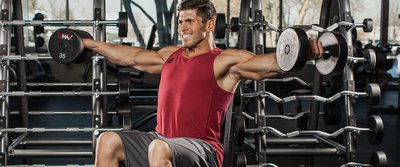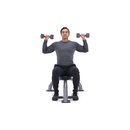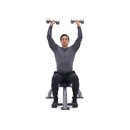Google "shoulder training" and you'll probably get millions of results written by millions of so-called experts. But how do you decide which articles and bits of information are correct, or right for your specific goals? With so much information available, how the heck do you even decide where to start?
Luckily, we've done all the legwork, cut through the millions of articles, and distilled the most critical information you need to know about shoulder training right here. Consider this article your crash course on building bigger, stronger shoulders, complete with essential tips and a solid muscle-building workout.
If you don't know how to train your shoulders, this is where you should start—step by step, exercise by exercise, and rep by rep.
1. Know Your Basic Anatomy
Your shoulders, or deltoids, are composed of three muscle heads—the front, middle, and rear—which sit in positions exactly as their names suggest relative to your collar bone. They are roughly the same size, but can be overdeveloped if you favor some kinds of exercises over others.
It's worth noting that the front, or anterior, delts heavily contribute in chest-pressing motions, especially as the degree of incline increases, while the rear (posterior) delts play a significant role in pulling motions on back day. If your deltoid heads become disproportionate, such as when you focus for too long on chest training, it can cause your shoulders to noticeably pull forward—commonly called slouched shoulders—and impact your supporting rotator cuffs, affecting their alignment.
The bottom line? For symmetry, appearances, and health, make an effort to train and develop all three of your deltoid heads equally!

"For symmetry, appearances, and health, make an effort to train and develop all three of your deltoid heads equally!"
2. Press Weight Overhead
Exercises are commonly divided into two camps: Multijoint and single-joint. The advantage of multijoint moves is that they recruit more muscle tissue than single-joint, or isolation, exercises, which allows you to push significantly heavier weights. Multijoint movements include the squat, bench press, deadlift, and many other "big" lifts. It's typically best to perform these kinds of exercises first in your workout when your energy is highest.
The largest group of multijoint movements for the shoulders are overhead presses, which can be done with a barbell or dumbbells, seated or standing, or on a machine. There are pros and cons to each press variation, but in general, the free-weight version is a better muscle builder than a machine press.
Shoulder presses target the middle and front delts to the greatest degree, though the rear delts also get some activity. They're a great starting movement for any shoulder workout.
3. Attack Each Deltoid Head Separately
After hammering your entire shoulder girdle with a pressing movement, it's time to isolate each head with single-joint exercises for more advanced development. You won't be able to use as much weight with these exercises, but that's OK.
Here's how to focus on each of the three delts with single-joint moves. Note that each of these exercises should be performed with a slight bend in your elbow.
- Front raise: Raise a barbell or dumbbell directly in front of your body to target your front delts.
- Lateral raise: Raise the weight directly up and out to your sides to work your middle delt.
- Reverse fly or bent-over lateral raise: Raise a weight up and out to your sides when you're in a bent-over position, or facing the bench on a pec-deck machine, to target the rear (posterior) delt.
You need to do each kind of movement in your routine to work all three areas of your shoulders for strong and symmetrical development.

"After hammering your entire shoulder girdle with a pressing movement, it's time to isolate each head with single-joint exercises for more advanced development."
4. Choose the Right Weight
To build muscle, choose a challenging weight you can do for 3 sets of 8-12 reps—after warming up your muscles, of course. Warm-ups may sound like a waste of time, but they actually allow you to rehearse the movement pattern—better establishing the mind-muscle connection—and enable you to move heavier weights than when you lift cold.
Take each set to muscle failure, which means you can't do any more reps with good form. If you can do more reps than the target rep range, the weight is too light, so add weight on your next set. If you can't reach the target rep range, then the weight is too heavy.
And remember, cheating to get a weight up brings other muscle groups into the movement, taking stress off the intended target muscle, and increases your risk of injury. Make sure your form is spot-on before handling more challenging weights.
Also, never take warm-up sets close to muscle failure. Going to failure with a low weight will sap your strength on your heavier sets.
5. Refine Your Rest Periods
Rest between sets is essential, to catch your breath and recover your strength, but you don't want to rest for too long, or not long enough. I suggest resting roughly 90 seconds between compound movements like overhead presses, and 60 seconds between single-joint exercises.
More demanding exercises require slightly longer rest intervals. Remember, too, that some exercises are done one arm at a time, which could lengthen the rest interval if you take the full minute of downtime. When doing such unilateral movements, you can decrease your "full" rest time to 30-40 seconds so each side isn't resting for longer than the intended length of time.
6. Turn Up the Volume
Volume is basically the amount of work you do, or the number of total working sets multiplied by reps. In a bodybuilding scheme, more volume is better than less—until it becomes too much.
One set of an exercise will do something, but not enough if you want bigger muscles. Beginners should do about 2-3 sets of 2-3 exercises for a given muscle group, while advanced trainees can tackle up to 6 exercises. That should provide sufficient training volume to stimulate the muscle, assuming you're using the right weights.
Ready to put all this newfound knowledge into practice? Try this standard but effective muscle-building shoulder workout!

Seated dumbbell overhead press

BodyFit
$6.99/month- 2,500+ expert-created single workouts
- 3,500+ how-to exercise videos
- Detailed workout instruction
- Step-by-step workout tips
- Training at gym or at home
- Access to Workout Plans
- Access to Bodyfit App
- Store Discounts
Already have a Bodybuilding.com account with BodyFit? Sign In

What comes with BodyFit?

- Instructional Videos
Don't risk doing a workout improperly! Avoid injury and keep your form in check with in-depth instructional videos.

- How-to Images
View our enormous library of workout photos and see exactly how each exercise should be done before you give it a shot.

- Step-by-Step Instructions
Quickly read through our step-by-step directions to ensure you're doing each workout correctly the first time, every time.
7. It's All About the Angles
Learn how to perform a given movement, such as a lateral raise, a variety of ways. This allows you to train the target muscle slightly differently, and from various angles, with multiple basic exercise variations. For example: Dumbbell lateral raises, machine lateral raises, and cable lateral raises are very similar movements, but they work the middle delt in slightly different ways. Incorporating each into your routine can, over time, build a more fully developed muscle.
This thinking holds true for other shoulder exercises you do as well. Develop a mental list of similar exercises for a basic movement pattern and you'll exponentially increase the number of ways you can do a workout. You'll also find that you can attack specific weaknesses in new ways by including new variations in your workout.
8. Vary Your Reps
The basic rep scheme presented above is a good one for building mass, but over time, muscles experience diminishing returns when following the exact same rep/weight scheme. If you're always doing a move for sets of 8 or 10 reps, you'll see fewer gains the longer you follow it.
Start manipulating your reps after you've been following the same routine for 4-6 weeks. For example, you could train very heavy some days on multijoint exercises for sets of 6. While you don't want to go too heavy on your single-joint exercises because of the stress they place on your joints, you're not always limited to a single rep target here, either.
Research pyramid schemes, reverse pyramid plans, back-off sets, and any number of other approaches that manipulate weight and reps. Rep targets should certainly fall within a range that matches your goals, but they're one more variable you can manipulate—in addition to exercise choice—that allows you to make continued gains.
9. Push Past Failure
For bodybuilding purposes, training to muscle failure is important, but taking 1-2 sets of an exercise past failure elicits even more muscle-tissue breakdown. So long as you don't overdo too much of a good thing (like volume), post-failure training techniques can help a more advanced lifter increase the demands on the working muscles, which respond by growing back larger and stronger.
If you have a workout partner, research techniques like forced reps, rest-pause, and negatives here on Bodybuilding.com. If you're training solo, check out rest-pause (on some machines), dropsets, and supersets to literally force your muscles to work harder.

Machine Overhead Press
10. Target Your Traps
You've probably noticed that the upper portion of your trapezius muscle—a large muscle group on your back—sits adjacent to the deltoids. In fact, your upper traps are commonly recruited into many delt exercises—notably overhead presses, lateral raises, and upright rows—though typically not through the exercise's full range of motion. Because of their involvement, many bodybuilders typically train the upper traps with shoulders.
The most basic movement that targets your upper traps is called a shrug. Adding 1-2 shrug movements to your shoulder routine is a natural progression as you become more experienced. You don't need to get fancy with your shrugs; simply elevate your shoulders to your ears while maintaining straight arms and a natural spinal position. The same rules regarding exercise choice, sets and reps, volume, and intensity apply here as well.




